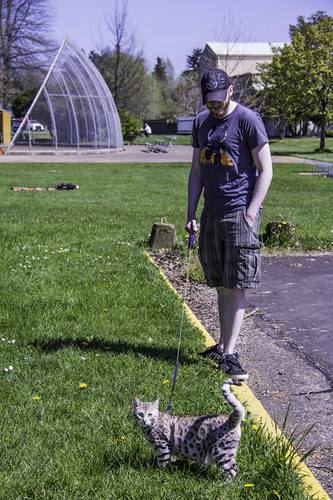 Needed supplies:
Needed supplies:- Harness
- Leash
- Cat
- Your cat's favorite edible treats
There are lots of types of cat harness types out there, but a regular basic harness has worked just fine for me and the girls seem to be comfortable in it. I got ours from PetSmart - they had a lot of great color options that Petco didn't have (and those are our two big store options in the area). In fact, I'm pretty sure we got these harnesses along with these leashes. We also have retractable leashes for park outings to allow them more range.
Leash training works best with a cat that is naturally active and curious. If your cat is not already prone to exploring and energetic play, you're going to have a much harder time. It's also easier to start with a young cat.
Most importantly: don't rush it. This process is likely going to take time.
The girls were first introduced to their harness and leash at about 15 weeks old (I think it was about 2 weeks after we got them and they'd settled into the new environment). We started out using the leashes and harness as play things so they'd associate them with fun and as being theirs.
After a few play sessions, we moved forward by putting the harnesses on them (only the harnesses) so they could get used to how they feel. Start with only a few minutes at a time in the harness, gradually lengthening the time depending on how they react to it. It's possible your cat's first reaction to the foreign thing on their body will be that they flop over with a look like they are convinced you're trying to kill them. Don't try to force them to walk in it, just let them be. Work up to getting them to play with and go through normal activities around the house with the harness on, no leash involved whatsoever.
Next, add in the leash. Never drag or pull or try to force your cat to go in a direction it doesn't want to. More than likely they will shut down, flop over, and try to kill you with their eyes. It's not very conducive to forward movement and could be the end of your hopes and dreams of kitty-led strolls in the park. This is where the treats come in. Holding the leash slack with no pressure at all, try to coax kitty forward with some of their favorite nibblies. Reward them every few steps. Slowly increase how many steps are required of them before you reward them with "Good kitty!" and a tasty treat. You also might consider incorporating a clicking sound (either from your mouth or a device) during this process so it can assist in replacing the treats at some point.
Positive association is key!
Using this process, we worked the girls up to full laps around the inside of the house with zero leash pulling and minimal treat giving. It took several sessions, but patience pays off. If your cat starts losing interest or is being difficult during one of your practice sessions don't try to force it - just de-harness the cat and save it for another day. You want the cat to think positively on the experience, and frustration will only discourage him/her.
 Your first outdoor experience will likely involve not much walking at all, but rather wide eyed kitty bewilderment and cautious sniffing. That's fine. Remember: a cat is not a dog. They play by different rules. Walking your cat outside is a privilege and not a right and your cat will be quick to remind you of that. You have to move at their pace and be patient, patient, patient.
Your first outdoor experience will likely involve not much walking at all, but rather wide eyed kitty bewilderment and cautious sniffing. That's fine. Remember: a cat is not a dog. They play by different rules. Walking your cat outside is a privilege and not a right and your cat will be quick to remind you of that. You have to move at their pace and be patient, patient, patient.We were nervous about taking the girls out the first time, so we opted to start with a more controlled environment: Petco. It's inside, works in all weather conditions, and if your kitty freaks out and gets away from you they can't get very far. Aisles also make good directional pathways - Mika and Mochi both tend to like paths and aisles more than wide open spaces. It gives them a sense of what direction they should go and boosts their confidence.
If you're super lucky, you'll eventually end up with a cat who gets excited when they see their harness and is willing to guide you around the walking paths at your local park or the sidewalks in your neighborhood, possibly even submitting to minimal directional suggestions. (Mika and Mochi will sometimes sit by the cabinet containing their harnesses and verbally ask for outings. It's a blessing and a curse.) If you're moderately lucky, your cat will tolerate the harness without the flopping glare of doom and be willing to hang around in your backyard with you occasionally. Hey, take what you can get, right?
Best of luck to you on your leash training excursions!

